A Study of Vanadate Group Substitution into Nanosized Hydroxyapatite Doped with Eu3+ Ions as a Potential Tissue Replacement Material
Abstract
:1. Introduction
2. Materials and Methods
2.1. Synthesis Method
2.2. Physicochemical Characterization
2.2.1. Material Characterization
2.2.2. Luminescence Properties
2.3. Evaluation of Biocompatibility
2.3.1. Preparation of Nanosized Vanadium-Substituted Hydroxyapatite Suspension
2.3.2. Cell Culture and Cytotoxicity Assay
2.3.3. Hemolysis Assay
2.3.4. Time Dependent Ion Release to SBF
3. Results and Discussion
3.1. Analysis of Structure and Morphology
3.2. Luminescence Properties
3.3. Biological Properties
3.4. Ion Release to SBF
4. Conclusions
Supplementary Materials
Author Contributions
Funding
Institutional Review Board Statement
Informed Consent Statement
Data Availability Statement
Acknowledgments
Conflicts of Interest
References
- Florencio-Silva, R.; Sasso, G.R.D.S.; Sasso-Cerri, E.; Simões, M.J.; Cerri, P.S. Biology of bone tissue: Structure, function, and factors that influence bone cells. BioMed Res. Int. 2015, 2015, 421746. [Google Scholar] [CrossRef] [Green Version]
- Lopes, D.; Martins-Cruz, C.; Oliveira, M.B.; Mano, J.F. Bone physiology as inspiration for tissue regenerative therapies. Biomaterials 2018, 185, 240–275. [Google Scholar] [CrossRef] [PubMed]
- Liu, Y.; Zhou, G.; Cao, Y. Recent progress in cartilage tissue engineering—Our experience and future directions. Engineering 2017, 3, 28–35. [Google Scholar] [CrossRef]
- Nicolaides, M.; Pafitanis, G.; Vris, A. Open tibial fractures: An overview. J. Clin. Orthop. Trauma 2021, 20, 101483. [Google Scholar] [CrossRef]
- Trabulsy, P.P.; Kerley, S.M.; Hoffman, W.Y. A prospective study of early soft tissue coverage of grade IIIB tibial fractures. J. Trauma 1994, 36, 661–668. [Google Scholar] [CrossRef]
- Calmar, E.A.; Vinci, R.J. The anatomy and physiolooy of bone fracture and healing. Clin. Ped. Emerg. Med. 2002, 3, 85–93. [Google Scholar] [CrossRef]
- Silver, J.; Schwab, M.E.; Popovich, P.G. Central nervous system regenerative failure: Role of oligodendrocytes, astrocytes, and microglia. Cold Spring Harb. Perspect. Biol. 2015, 7, a020602. [Google Scholar] [CrossRef] [Green Version]
- Watson, E.C.; Adams, R.H. Biology of bone: The vasculature of the skeletal system. Cold Spring Harb. Perspect. Med. 2018, 8, a031559. [Google Scholar] [CrossRef] [PubMed]
- Huysseune, A. Skeletal system. In The Laboratory Fish; Academic Press: Cambridge, MA, USA, 2000. [Google Scholar]
- Marsell, R.; Einhorn, T. The biology of fracture healing. Injury 2011, 42, 551–555. [Google Scholar] [CrossRef] [Green Version]
- Perez, J.R.; Kouroupis, D.; Li, D.J.; Best, T.M.; Kaplan, L.; Correa, D. Tissue engineering and cell-based therapies for fractures and bone defects. Front. Bioeng. Biotechnol. 2018, 6, 1–23. [Google Scholar] [CrossRef] [Green Version]
- Li, Y.; Zheng, X.; Chu, Q. Bio-based nanomaterials for cancer therapy. Nano Today 2021, 38, 101134. [Google Scholar] [CrossRef]
- Zhang, R.X.; Li, J.; Zhang, T.; Amini, M.A.; He, C.; Lu, B.; Ahmed, T.; Lip, H.; Rauth, A.M.; Wu, X.Y. Importance of integrating nanotechnology with pharmacology and physiology for innovative drug delivery and therapy—An illustration with firsthand examples. Acta Pharmacologica Sinica 2018, 39, 825–844. [Google Scholar] [CrossRef] [PubMed] [Green Version]
- Kumar Dash, D.; Kant Panik, R.; Kumar Sahu, A.; Tripathi, V. Role of nanobiotechnology in drug discovery, development and molecular diagnostic. In Applications of Nanobiotechnology; IntechOpen: London, UK, 2020. [Google Scholar]
- Antoniac, I.V. Cationic and anionic substitutions in hydroxyapatite. In Handbook of Bioceramics and Biocomposites; Springer International Publishing: Cham, Switzerland, 2016. [Google Scholar]
- Cacciotti, I. Multisubstituted hydroxyapatite powders and coatings: The influence of the codoping on the hydroxyapatite performances. Int. J. Appl. Ceram. Technol. 2019, 16, 1864–1884. [Google Scholar] [CrossRef]
- Swetha, M.; Sahithi, K.; Moorthi, A.; Srinivasan, N.; Ramasamy, K.; Selvamurugan, N. Biocomposites containing natural polymers and hydroxyapatite for bone tissue engineering. Int. J. Biol. Macromol. 2010, 47, 1–4. [Google Scholar] [CrossRef]
- Odusote, J.K.; Danyuo, Y.; Baruwa, A.D.; Azeez, A.A. Synthesis and characterization of hydroxyapatite from bovine bone for production of dental implants. J. Appl. Biomater. Funct. Mater. 2019, 17, 1–7. [Google Scholar] [CrossRef] [PubMed]
- Ventura, R. Bone regeneration of decellularized in-vivo deposited extracellular matrix (ECM) on hydroxyapatite sponge scaffold. MOJ Cell Sci. Rep. 2016, 3, 3–6. [Google Scholar] [CrossRef] [Green Version]
- Szcześ, A.; Hołysz, L.; Chibowski, E. Synthesis of hydroxyapatite for biomedical applications. Adv. Colloid Interface Sci. 2017, 249, 321–330. [Google Scholar] [CrossRef] [PubMed]
- Zou, Q.; Li, Y.; Zhang, L.; Zuo, Y.; Li, J.; Li, X. Characterization and cytocompatibility of nano-hydroxyapatite/chitosan bone cement with the addition of calcium salts. J. Biomed. Mater. Res. Part B Appl. Biomater. 2009, 90, 156–164. [Google Scholar] [CrossRef]
- Calasans-Maia, M.D.; de Melo, B.R.; Alves, A.T.N.N.; Resende, R.F.D.B.; Louro, R.S.; Sartoretto, S.C.; Granjeiro, J.M.; Alves, G.G. Cytocompatibility and biocompatibility of nanostructured carbonated hydroxyapatite spheres for bone repair. J. Appl. Oral Sci. 2015, 23, 599–608. [Google Scholar] [CrossRef] [PubMed]
- Huang, B.; Caetano, G.; Vyas, C.; Blaker, J.J.; Diver, C.; Bártolo, P. Polymer-ceramic composite scaffolds: The effect of hydroxyapatite and β-tri-calcium phosphate. Materials 2018, 11, 129. [Google Scholar] [CrossRef] [Green Version]
- Bianco, A.; Bozzo, B.M.; del Gaudio, C.; Cacciotti, I.; Armentano, I.; Dottori, M.; D’Angelo, F.; Martino, S.; Orlacchio, A.; Kenny, J.M. Poly (L-lactic acid)/calcium-deficient nanohydroxyapatite electrospun mats for bone marrow stem cell cultures. J. Bioact. Compat. Polym. 2011, 26, 225–241. [Google Scholar] [CrossRef]
- Han, Y.; Wang, X.; Li, S. Biocompatible europium doped hydroxyapatite nanoparticles as a biological fluorescent probe. Curr. Nanosci. 2010, 6, 178–183. [Google Scholar] [CrossRef]
- Xie, Y.; He, W.; Li, F.; Perera, T.S.H.; Gan, L.; Han, Y.; Wang, X.; Li, S.; Dai, H. Luminescence enhanced Eu3+/Gd3+ co-doped hydroxyapatite nanocrystals as imaging agents in vitro and in vivo. ACS Appl. Mater. Interfaces 2016, 8, 10212–10219. [Google Scholar] [CrossRef]
- Andronescu, E.; Predoi, D.; Neacsu, I.A.; Paduraru, A.V.; Musuc, A.M.; Trusca, R.; Oprea, O.; Tanasa, E.; Vasile, O.R.; Nicoara, A.I.; et al. Photoluminescent hydroxylapatite: Eu3+ doping effect on biological behaviour. Nanomaterials 2019, 9, 1187. [Google Scholar] [CrossRef] [Green Version]
- García Domínguez, G.; Garrido Hernández, A.; Cerón Montes, G.; Morales Ramírez, A.J.; de la Torre, S.D. Structural and luminescent properties of europium-doped and undoped hydroxyapatite powders sintered by spark plasma. Ceramics–Silikaty 2019, 63, 100–109. [Google Scholar] [CrossRef] [Green Version]
- Escudero, A.; Calvo, M.E.; Rivera-ferna, S. Microwave-assisted synthesis of biocompatible europium-doped calcium hydroxyapatite and fluoroapatite luminescent nanospindles functionalized with poly(acrylic acid). Langmuir 2013, 29, 1985–1994. [Google Scholar] [CrossRef] [PubMed] [Green Version]
- Chen, F.; Zhu, Y.J.; Zhang, K.H.; Wu, J.; Wang, K.W.; Tang, Q.L.; Mo, X.M. Europium-doped amorphous calcium phosphate porous nanospheres: Preparation and application as luminescent drug carriers. Nanoscale Res. Lett. 2011, 6, 1–9. [Google Scholar] [CrossRef] [PubMed] [Green Version]
- Yang, P.; Quan, Z.; Li, C.; Kang, X.; Lian, H.; Lin, J. Bioactive, luminescent and mesoporous europium-doped hydroxyapatite as a drug carrier. Biomaterials 2008, 29, 4341–4347. [Google Scholar] [CrossRef]
- Carpenter, C.M.; Sun, C.; Pratx, G.; Rao, R.; Xing, L. Hybrid X-ray/optical luminescence imaging: Characterization of experimental conditions. Med Phys. 2010, 37, 4011–4018. [Google Scholar] [CrossRef] [Green Version]
- Kandarakis, I.; Cavouras, D.; Panayiotakis, G.S.; Triantis, D.; Nomicos, C.D. Europium-activated phosphors for use in X-ray detectors of medical imaging systems. Eur. Radiol. 1998, 8, 313–318. [Google Scholar] [CrossRef]
- Zhang, W.; Lan, Y.; Ma, M.; Chai, S.; Zuo, Q.; Kim, K.H.; Gao, Y. A novel chitosan–vanadium-titanium-magnetite composite as a superior adsorbent for organic dyes in wastewater. Environ. Int. 2020, 142, 105798. [Google Scholar] [CrossRef]
- Babar, B.M.; Mohite, A.A.; Patil, V.L.; Pawar, U.T.; Kadam, L.D.; Kadam, P.M.; Patil, P.S. Sol-gel prepared vanadium oxide for photocatalytic degradation of methylene blue dye. Mater. Today Proc. 2021, 43, 2673–2677. [Google Scholar] [CrossRef]
- Oliveira, H.S.; Oliveira, L.C.A.; Pereira, M.C.; Ardisson, J.D.; Souza, P.P.; Patrício, P.O.; Moura, F.C.C. Nanostructured vanadium-doped iron oxide: Catalytic oxidation of methylene blue dye. New J. Chem. 2015, 39, 3051–3058. [Google Scholar] [CrossRef]
- Treviño, S.; Díaz, A.; Sánchez-Lara, E.; Sanchez-Gaytan, B.L.; Perez-Aguilar, J.M.; González-Vergara, E. Vanadium in biological action: Chemical, pharmacological aspects, and metabolic implications in diabetes mellitus. Biol. Trace Elem. Res. 2019, 188, 68–98. [Google Scholar] [CrossRef] [PubMed] [Green Version]
- Odate, S.; Pawlik, J.R. The role of vanadium in the chemical defense of the solitary tunicate, Phallusia nigra. J. Chem. Ecol. 2007, 33, 643–654. [Google Scholar] [CrossRef] [PubMed]
- Malinovsky, D.; Kashulin, N.A. Vanadium isotope ratio measurements in fruit-bodies of: Amanita muscaria. Anal. Methods 2016, 8, 5921–5929. [Google Scholar] [CrossRef]
- Gerling, N.; Culmsee, C.; Klumpp, S.; Krieglstein, J. The tyrosine phosphatase inhibitor orthovanadate mimics NGF-induced neuroprotective signaling in rat hippocampal neurons. Neurochem. Int. 2004, 44, 505–520. [Google Scholar] [CrossRef]
- Morita, A.; Zhu, J.; Suzuki, N.; Enomoto, A.; Matsumoto, Y.; Tomita, M.; Suzuki, T.; Ohtomo, K.; Hosoi, Y. Sodium orthovanadate suppresses DNA damage-induced caspase activation and apoptosis by inactivating P53. Cell Death Differ. 2006, 13, 499–511. [Google Scholar] [CrossRef]
- Morita, A.; Yamamoto, S.; Wang, B.; Tanaka, K.; Suzuki, N.; Aoki, S.; Ito, A.; Nanao, T.; Ohya, S.; Yoshino, M.; et al. Sodium orthovanadate inhibits P53-mediated apoptosis. Cancer Res. 2010, 70, 257–265. [Google Scholar] [CrossRef] [PubMed] [Green Version]
- Uthus, E.O.; Nielsen, F.H. Effect of vanadium, iodine and their interaction on growth, blood variables, liver trace elements and thyroid status indices in rats. Magnes. Trace Elem. 1990, 9, 219–226. [Google Scholar]
- Matsumoto, J.; Morioka, M.; Hasegawa, Y.; Kawano, T.; Yoshinaga, Y.; Maeda, T.; Yano, S.; Kai, Y.; Fukunaga, K.; Kuratsu, J. Sodium orthovanadate enhances proliferation of progenitor cells in the adult rat subventricular zone after focal cerebral ischemia. J. Pharmacol. Exp. Ther. 2006, 318, 982–991. [Google Scholar] [CrossRef] [PubMed] [Green Version]
- Hazard, S.W.; Zwemer, C.F.; Mackay, D.R.; Koduru, S.V.; Ravnic, D.J.; Ehrlich, H.P. Topical vanadate enhances the repair of median laparotomy incisions. J. Surg. Res. 2017, 207, 102–107. [Google Scholar] [CrossRef] [PubMed]
- Wang, B.; Tanaka, K.; Morita, A.; Ninomiya, Y.; Maruyama, K.; Fujita, K.; Hosoi, Y.; Nenoi, M. Sodium orthovanadate (vanadate), a potent mitigator of radiation-induced damage to the hematopoietic system in mice. J. Radiat. Res. 2013, 54, 620–629. [Google Scholar] [CrossRef] [PubMed] [Green Version]
- Binnemans, K. Interpretation of europium(III) spectra. Coord. Chem. Rev. 2015, 295, 1–45. [Google Scholar] [CrossRef] [Green Version]
- Werts, M.H.V.; Jukes, R.T.F.; Verhoeven, J.W. The emission spectrum and the radiative lifetime of Eu3+ in luminescent lanthanide complexes. Phys. Chem. Chem. Phys. 2002, 4, 1542–1548. [Google Scholar] [CrossRef]
- Cacciotti, I.; Bianco, A.; Pezzotti, G.; Gusmano, G. Synthesis, thermal behaviour and luminescence properties of rare earth-doped titania nanofibers. Chem. Eng. J. 2011, 166, 751–764. [Google Scholar] [CrossRef]
- Kokubo, T. Bioactive glass ceramics: Properties and applications. Biomaterials 1991, 12, 155–163. [Google Scholar] [CrossRef]
- Kokubo, T.; Kushitani, H.; Sakka, S.; Kitsugi, T.; Yamamum, T. Solutions able to reproduce in vivo surface-structure changes in bioactive glass-ceramic A-W3. J. Biomed. Mater. Researc. 1990, 24, 721–734. [Google Scholar] [CrossRef]
- Holder, C.F.; Schaak, R.E. Tutorial on powder X-ray diffraction for characterizing nanoscale materials. ACS Nano 2019, 13, 7359–7365. [Google Scholar] [CrossRef] [Green Version]
- Mittemeijer, E.J.; Welzel, U. The “state of the art” of the diffraction analysis of crystallite size and lattice strain. Zeitschrift für Kristallographie 2008, 223, 552–560. [Google Scholar] [CrossRef]
- Ogo, S.; Onda, A.; Yanagisawa, K. Hydrothermal synthesis of vanadate-substituted hydroxyapatites, and catalytic properties for conversion of 2-propanol. Appl. Catal. A Gen. 2008, 348, 129–134. [Google Scholar] [CrossRef]
- Onda, A.; Ogo, S.; Kajiyoshi, K.; Yanagisawa, K. Hydrothermal synthesis of vanadate/phosphate hydroxyapatite solid solutions. Mater. Lett. 2008, 62, 1406–1409. [Google Scholar] [CrossRef]
- Kalniņa, D.; Levina, A.; Pei, A.; Gross, K.A.; Lay, P.A. Synthesis, characterization and in vitro anti-cancer activity of vanadium-doped nanocrystalline hydroxyapatite. New J. Chem. 2019, 43, 17891–17901. [Google Scholar] [CrossRef]
- Ogo, S.; Onda, A.; Kajiyoshi, K.; Yanagisawa, K. Hydrothermal synthesis and particle size control of hydroxyapatite solid solutions with vanadate. Phosphorus Res. Bull. 2007, 21, 84–87. [Google Scholar] [CrossRef]
- Saville, A.I.; Creuziger, A.; Mitchell, E.B.; Vogel, S.C.; Benzing, J.T.; Klemm-Toole, J.; Clarke, K.D.; Clarke, A.J. MAUD rietveld refinement software for neutron diffraction texture studies of single- and dual-phase materials. Integr. Mater. Manuf. Innov. 2021, 10, 461–487. [Google Scholar] [CrossRef]
- Rietveld, H.M. A profile refinement method for nuclear and magnetic structures. J. Appl. Crystallogr. 1969, 2, 65–71. [Google Scholar] [CrossRef]
- Sobierajska, P.; Wiglusz, R.J. Influence of Li+ ions on the physicochemical properties of nanocrystalline calcium-strontium hydroxyapatite doped with Eu3+ ions. New J. Chem. 2019, 43, 14908–14916. [Google Scholar] [CrossRef]
- Hanifi, A.; Fathi, M.H. Bioresorbability evaluation of hydroxyapatite nanopowders in a stimulated body fluid medium. Iran. J. Pharm. Sci. 2008, 4, 141–148. [Google Scholar]
- Gheisari, H.; Karamian, E.; Abdellahi, M. A novel hydroxyapatite-hardystonite nanocomposite ceramic. Ceram. Int. 2015, 41, 5967–5975. [Google Scholar] [CrossRef]
- Taxak, V.B.; Sheetal; Dayawati; Khatkar, S.P. Synthesis, structural and optical properties of Eu3+-doped Ca2V2O7 nanophosphors. Curr. Appl. Phys. 2013, 13, 594–598. [Google Scholar] [CrossRef]
- Thiagarajan, K.; Theerthagiri, J.; Senthil, R.A.; Madhavan, J. Simple and low cost electrode material based on Ca2V2O7/PANI nanoplatelets for supercapacitor applications. J. Mater. Sci. Mater. Electron. 2017, 28, 17354–17362. [Google Scholar] [CrossRef]
- Yu, H.; Song, H.; Pan, G.; Qin, R.; Fan, L.; Zhang, H.; Bai, X.; Li, S.; Zhao, H.; Lu, S. Preparation and luminescent properties of YVO4:Eu3+ nanofibers by electrospinning. J. Nanosci. Nanotechnol. 2008, 8, 1432–1436. [Google Scholar] [CrossRef] [PubMed]
- Sharma, A.; Varshney, M.; Chae, K.H.; Won, S.O. Electronic structure and luminescence assets in white-light emitting Ca2V2O7, Sr2V2O7 and Ba2V2O7 pyro-vanadates: X-ray absorption spectroscopy investigations. RSC Adv. 2018, 8, 26423–26431. [Google Scholar] [CrossRef] [Green Version]
- Suvorova, E.I.; Buffat, P.A. Electron diffraction from micro- and nanoparticles of hydroxyapatite. J. Microsc. 1999, 196, 46–58. [Google Scholar] [CrossRef] [Green Version]
- Zhuang, Z.; Miki, T.; Yumoto, M.; Konishi, T.; Aizawa, M. Ultrastructural observation of hydroxyapatite ceramics with preferred orientation to a-plane using high-resolution transmission electron microscopy. Procedia Eng. 2012, 36, 121–127. [Google Scholar] [CrossRef] [Green Version]
- Targonska, S.; Wiglusz, R.J. Investigation of physicochemical properties of the structurally modified nanosized silicate-substituted hydroxyapatite co-doped with Eu3+ and Sr2+ ions. Nanomaterials 2021, 11, 27. [Google Scholar] [CrossRef] [PubMed]
- Szyszka, K.; Targonska, S.; Gazinska, M.; Szustakiewicz, K.; Wiglusz, R.J. The comprehensive approach to preparation and investigation of the Eu3+ doped hydroxyapatite/poly(L-lactide) nanocomposites: Promising materials for theranostics application. Nanomaterials 2019, 9, 1146. [Google Scholar] [CrossRef] [Green Version]
- Bunzli, J.C.G.; Plancherel, D.; Pradervand, G.O. Eu(III) ion as luminescent probe: Structural investigation of complexes between europium nitrate and two polyethers. J. Phys. Chem. 1989, 93, 980–984. [Google Scholar] [CrossRef]
- Kumar, V.; Bedyal, A.K.; Sharma, J.; Kumar, V.; Ntwaeaborwa, O.M.; Swart, H.C. Spectral and surface investigations of Ca2V2O 7:Eu3+ nanophosphors prepared by citrate-gel combustion method: A potential red-emitting phosphor for near-UV light-emitting diodes. Appl. Phys. A Mater. Sci. Process. 2014, 116, 1785–1792. [Google Scholar] [CrossRef]
- Pogosova, M.A.; Azarmi, F.; Eliseev, A.A.; Kazin, P.E. Eu and Cu co-substituted calcium vanadate—The crystal structure, luminescence and color. Dyes Pigment. 2018, 148, 219–223. [Google Scholar] [CrossRef]
- Ciobanu, C.S.; Iconaru, S.L.; Massuyeau, F.; Constantin, L.V.; Costescu, A.; Predoi, D. Synthesis, structure, and luminescent properties of europium-doped hydroxyapatite nanocrystalline powders. J. Nanomater. 2012. [Google Scholar] [CrossRef] [Green Version]
- Wujczyk, M.; Watras, A.; Wiglusz, R.J. The study of the influence of PH on the structural and spectroscopic properties of nanocrystalline Eu3+ ion-doped yttrium orthovanadate. Dalton Trans. 2021, 50, 3724–3733. [Google Scholar] [CrossRef]
- Wujczyk, M.; Watras, A.; Boutinaud, P.; Bettinelli, M.; Targonska, S.; Hölsä, J.; Wiglusz, R.J. Emission quenching and first evidence of Tb3+-to-As5+ charge transfer in terbium(III) ion-doped YVXAs1−XO4 solid-state solution. J. Phys. Chem. C 2020, 124, 17364–17371. [Google Scholar] [CrossRef]
- Guan, R.G.; Johnson, I.; Cui, T.; Zhao, T.; Zhao, Z.Y.; Li, X.; Liu, H. Electrodeposition of hydroxyapatite coating on Mg-4.0 Zn-1.0 Ca-0.6 Zr alloy and in vitro evaluation of degradation, hemolysis, and cytotoxicity. J. Biomed. Mater. Res. Part A 2012, 100 A, 999–1015. [Google Scholar] [CrossRef]
- Ii, H. Vanadium metabolism in sheep. I. comparative and acute toxicity of vanadium compounds in sheep. J. Anim. Sci. 1982, 55, 344–349. [Google Scholar]
- Wilk, A.; Szypulska-Koziarska, D.; Wiszniewska, B. The toxicity of vanadium on gastrointestinal, urinary and reproductive system, and its influence on fertility and fetuses malformations. Postepy Higieny i Medycyny Doswiadczalnej 2017, 71, 850–859. [Google Scholar] [CrossRef] [PubMed]
- Ghosh, S.K.; Saha, R.; Saha, B. Toxicity of inorganic vanadium compounds. Res. Chem. Intermed. 2015, 41, 4873–4897. [Google Scholar] [CrossRef]

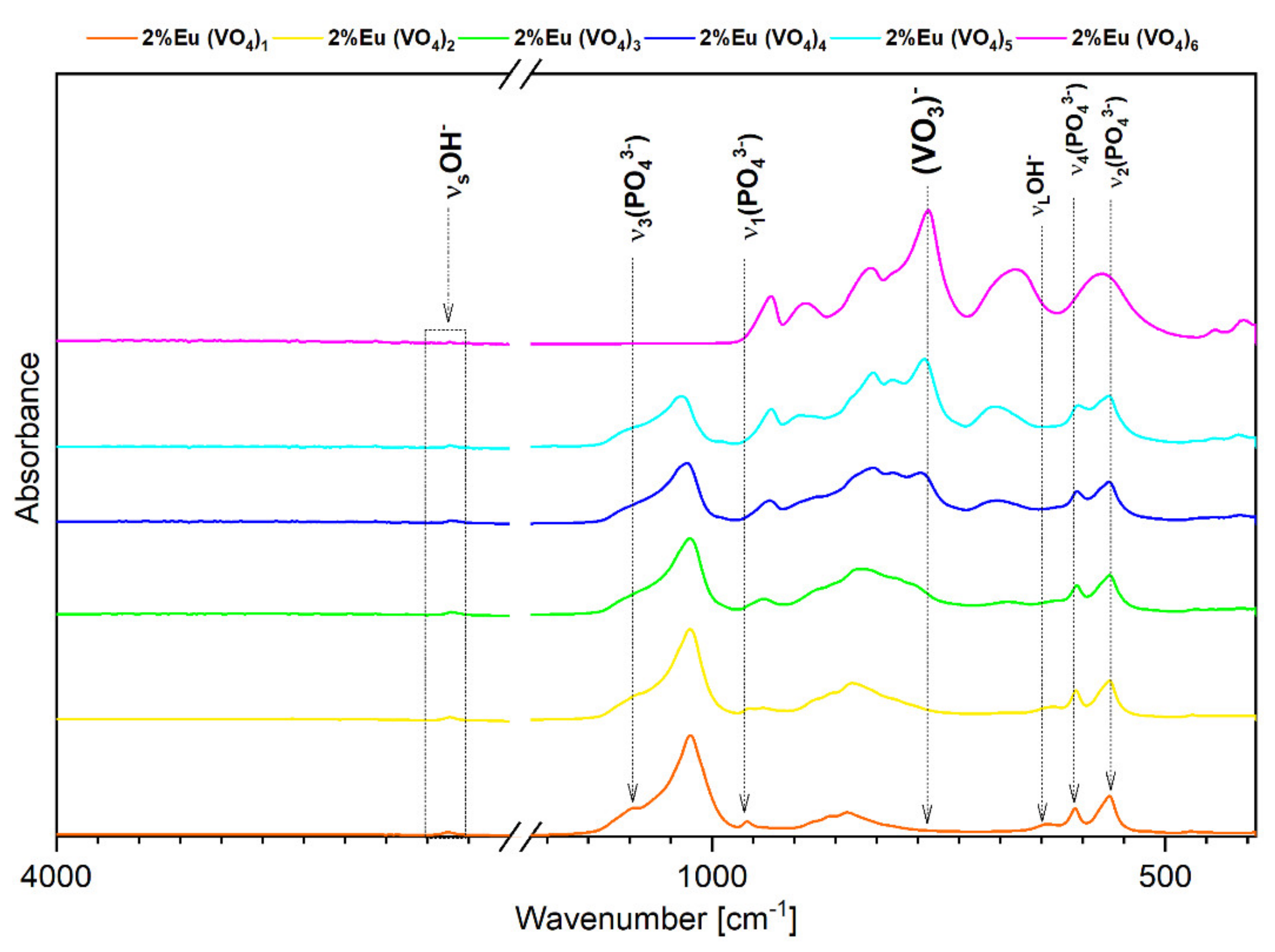
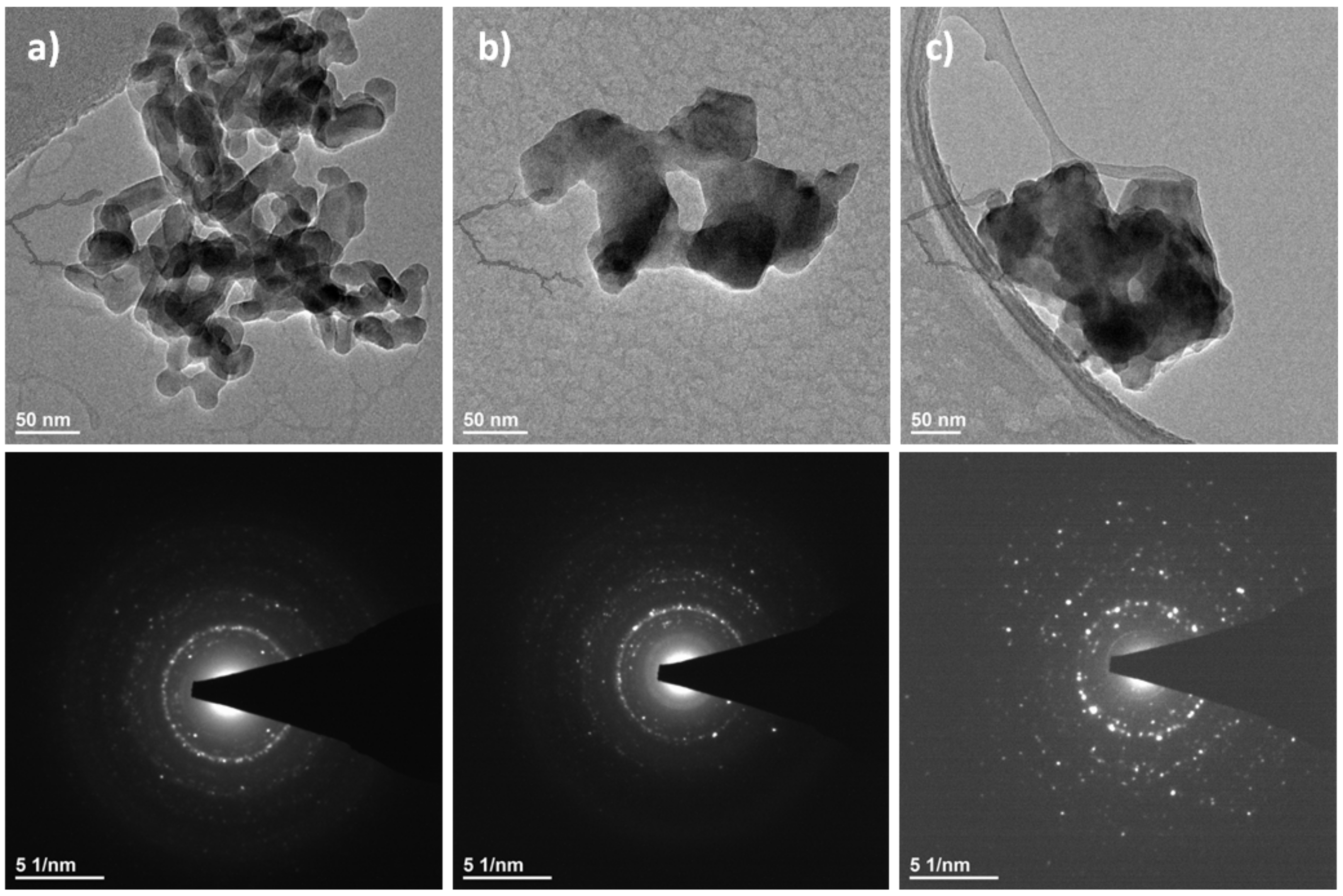


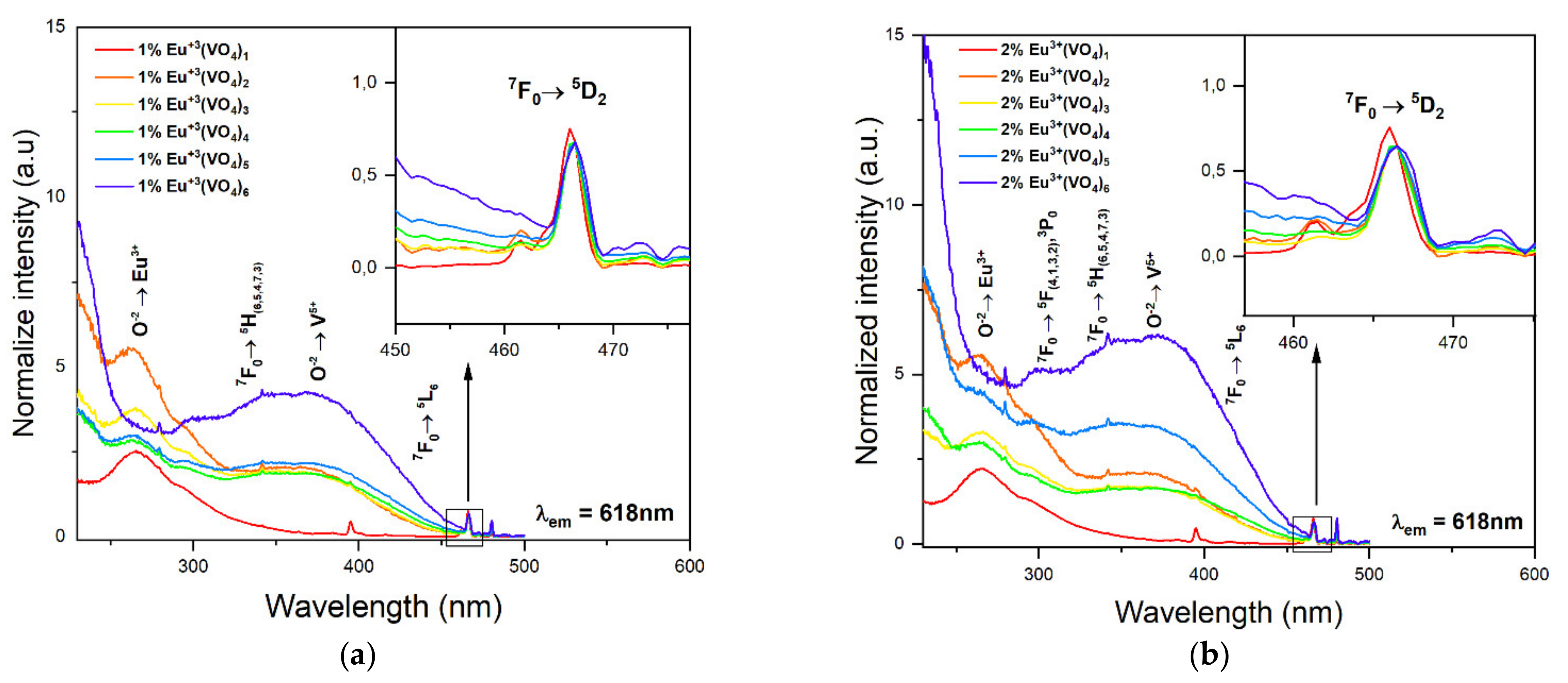


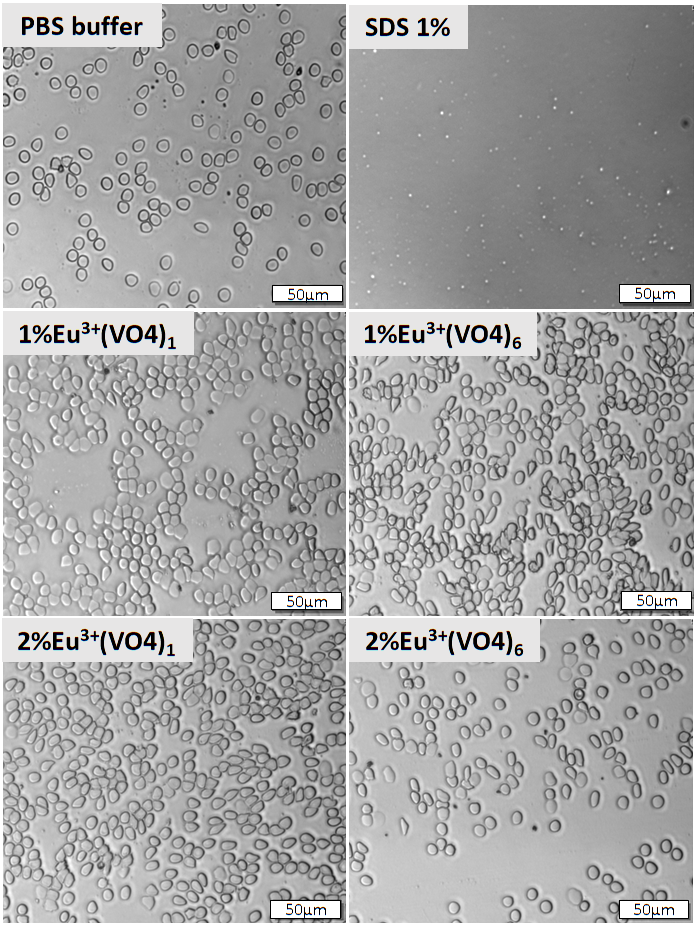
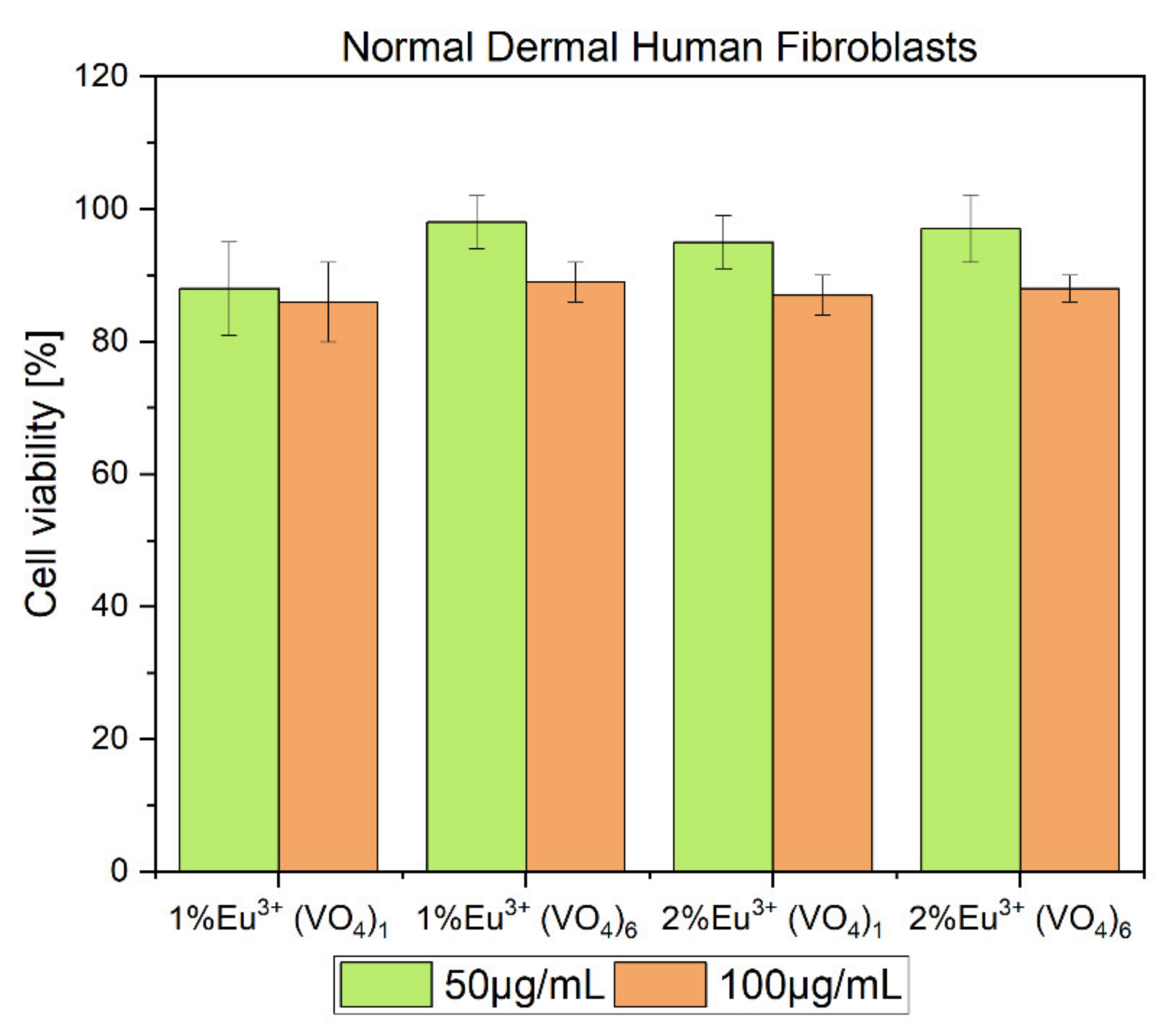
| Sample | ICP OES Technique Results | |||
|---|---|---|---|---|
| n P [mol] | n Ca [mol] | n V [mol] | n Eu [mol] | |
| Ca9.8Eu0.2(PO4)5(VO4)1(OH)2 | 6.35 | 9.75 | 1.30 | 0.25 |
| Ca9.8Eu0.2(PO4)4(VO4)2(OH)2 | 4.32 | 9.72 | 0.68 | 0.28 |
| Ca9.8Eu0.2(PO4)3(VO4)3(OH)2 | 5.37 | 9.74 | 0.45 | 0.26 |
| Time of Incubation (min) | Ca | P | Eu | V |
|---|---|---|---|---|
| 0 | 11 ± 0.5 ppm | 2.45 ± 0.1 ppm | ||
| 5 | 11.4 ± 0.5 ppm | 2.6 ± 0.1 ppm | ||
| 15 | 12.32 ± 0.5 ppm | 2.73 ± 0.1 ppm | ||
| 30 | 12.64 ± 0.6 ppm | 2.758 ± 0.1 ppm | ||
| 45 | 12.87 ± 0.6 ppm | 2.77 ± 0.1 ppm | 0.266 ± 0.01 ppm | |
| 60 | 13.34 ± 0.7 ppm | 2.806 ± 0.15 ppm | 0.315 ± 0.015 ppm | |
| 360 | 13.58 ± 0.7 ppm | 2.8 ± 0.15 ppm | 0.543 ± 0.015 ppm | |
| 1440 | 13.84 ± 0.7 ppm | 2.8 ± 0.15 ppm | 1.227 ± 0.06 ppm |
| Time of Incubation (min) | Ca | P | Eu | V |
|---|---|---|---|---|
| 0 | 11 ± 0.5 ppm | 2.84 ± 0.15 ppm | ||
| 5 | 11.3 ± 0.5 ppm | 2.846 ± 0.15 ppm | ||
| 15 | 12.12 ± 0.6 ppm | 2.897 ± 0.15 ppm | ||
| 30 | 12.24 ± 0.6 ppm | 2.894 ± 0.15 ppm | <0.1 ± 0 ppm | 0.2 ± 0.01 ppm |
| 45 | 12.71 ± 0.6 ppm | 2.9 ± 0.15 ppm | <0.1 ± 0 ppm | 0.286 ± 0.015 ppm |
| 60 | 12.77 ± 0.6 ppm | 2.9 ± 0.15 ppm | <0.1± 0 ppm | 0.351 ± 0.02 ppm |
| 360 | 13.94 ± 0.7 ppm | 2.903 ± 0.15 ppm | <0.1 ± 0 ppm | 0.657 ± 0.03 ppm |
| 1440 | 14.9 ± 0.7 ppm | 2.9 ± 0H.15 ppm | <0.1± 0 ppm | 1.291 ± 0.06 ppm |
Publisher’s Note: MDPI stays neutral with regard to jurisdictional claims in published maps and institutional affiliations. |
© 2021 by the authors. Licensee MDPI, Basel, Switzerland. This article is an open access article distributed under the terms and conditions of the Creative Commons Attribution (CC BY) license (https://creativecommons.org/licenses/by/4.0/).
Share and Cite
Nowak, N.; Wiglusz, R.J. A Study of Vanadate Group Substitution into Nanosized Hydroxyapatite Doped with Eu3+ Ions as a Potential Tissue Replacement Material. Nanomaterials 2022, 12, 77. https://doi.org/10.3390/nano12010077
Nowak N, Wiglusz RJ. A Study of Vanadate Group Substitution into Nanosized Hydroxyapatite Doped with Eu3+ Ions as a Potential Tissue Replacement Material. Nanomaterials. 2022; 12(1):77. https://doi.org/10.3390/nano12010077
Chicago/Turabian StyleNowak, Nicole, and Rafal Jakub Wiglusz. 2022. "A Study of Vanadate Group Substitution into Nanosized Hydroxyapatite Doped with Eu3+ Ions as a Potential Tissue Replacement Material" Nanomaterials 12, no. 1: 77. https://doi.org/10.3390/nano12010077
APA StyleNowak, N., & Wiglusz, R. J. (2022). A Study of Vanadate Group Substitution into Nanosized Hydroxyapatite Doped with Eu3+ Ions as a Potential Tissue Replacement Material. Nanomaterials, 12(1), 77. https://doi.org/10.3390/nano12010077








